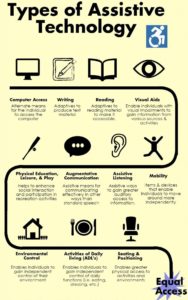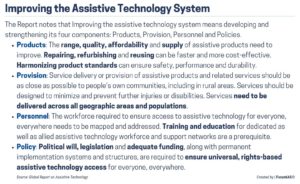ForumIAS announcing GS Foundation Program for UPSC CSE 2025-26 from 19 April. Click Here for more information.
Contents
- 1 Introduction
- 2 What is meant by Assistive Technology?
- 3 What are the key findings of the WHO Report?
- 4 What is the situation regarding disability in India?
- 5 What is the significance of Assistive Technology?
- 6 What are the barriers in accessing Assistive Technologies?
- 7 What steps have been taken for persons with disabilities?
- 8 What further steps can be taken?
- 9 Conclusion
| For 7PM Editorial Archives click HERE → |
Introduction
The WHO and UNICEF recently released the Global Report on Assistive Technology. The Report has been developed in response to the World Health Assembly resolution (WHA71.8) on improving access to assistive technology. The resolution was adopted in May 2018. The Report assumes significance as globally 90% of those who need assistive technology do not have access to it. The Report is expected to play an instrumental role in setting the global roadmap for improving access to assistive technology for everyone, everywhere. It is primarily directed at policy-makers, providers of assistive technology, donors and funding agencies, and industry leaders.
What is meant by Assistive Technology?
These include any item, piece of equipment, software programme or product system that is used to increase, maintain, or improve the functional capabilities of persons with disabilities. These aids could be (a) Physical products such as wheelchairs, eyeglasses, hearing aids, prostheses, walking devices or continence pads; (b) Digital such as software and apps that support communication and time management; or (c) Adaptations to the physical environment, for example, portable ramps or grab-rails.
Different disabilities require different assistive technologies, and these are designed to help people who have difficulty speaking, typing, writing, remembering, seeing, hearing, learning, or walking.
Source: edtechnology.co.uk
What are the key findings of the WHO Report?
The GReAT report draws upon surveys conducted in 20 countries. These indicate that the proportion of the population currently using at least one assistive product ranges from less than 3% to about 70%. This indicates widespread disparity in access to assistive technology.
More than 2.5 billion people need one or more assistive products, such as wheelchairs, hearing aids, or apps that support communication and cognition.
A billion of them are denied access, particularly in low- and middle-income countries, where access can be as low as 3% of the need for these life-changing products.
What is the situation regarding disability in India?
The 2011 Census puts the national estimate of the number of people with disabilities at 2.21% of the total population (26.8 million persons). This includes persons with visual, hearing, speech, locomotor and mental disabilities with the majority in the 19-59 age group.
Amongst the people with disabilities, 49% are literate, 34% employed and 75% live in rural areas. The country’s disabled population increased by 22.4% between 2001 and 2011 census periods.
The 76th round (July-December 2018) of the National Sample Survey (NSS) reported that among persons with disabilities, 21.8% reported receiving aid/help from the government and another 1.8% from other organizations.
What is the significance of Assistive Technology?
Ease in Day to Day activities: As a life changer, assistive technology (AT) can support people in need in all aspects of life. Using AT, a child can go to school, make friends, and participate in sports and recreation like any other child in the school or community. Adults can be independent and access higher education and jobs, carry out household activities, and participate in social life. For instance, Arunima Sinha used Jaipur Foot to climb Mount Everest and became the first female amputee to do so.
Realization of True potential: It helps an individual to overcome barriers and unleash its true potential. For instance, Stephen Hawking used an assisted communication system and a speech synthesizer to compose lectures and papers. This helped him emerge as one of the greatest physicists and cosmologists of all time.
Prevents Isolation and Hardships: Without assistive products, people may suffer exclusion, be at risk of isolation and live in poverty. They may face hunger, and be forced to depend more on family, community and government support.
Achieving SDGs: Including assistive technology into health systems is critical for progress towards the Sustainable Development Goals (SDG) especially SDG 3 which calls for Universal Health Coverage (UHC).
What are the barriers in accessing Assistive Technologies?
First, there is lack of awareness that often drives low uptake, compounded by an absence of information on the types and availability of assistive products.
Second, high costs due to over-priced assistive products and associated service delivery cost is one of the most common barriers.
Third, limited physical and geographical access puts assistive technology out of reach for many potential users.
Fourth, inadequate product range, quantity, quality and suitability can make assistive products unavailable, unsafe, ineffective and even abandoned. Further, Procurement and delivery challenges delay and reduce access.
Fifth, capacity gaps exist in the assistive technology workforce along with a shortage of workforce with adequate knowledge.
Sixth, low policy profile and lack of legislation lead to the low prioritization of assistive technology, and in many cases legislation fails to cover people with all types of functional difficulty.
Seventh, Lack of funding and investment for the strengthening of national assistive technology systems exists in many countries which restricts access to the marginalized section.
Eighth, there is Fragmentation of the assistive technology sector, including between professions, user groups, funding and provision mechanisms.
What steps have been taken for persons with disabilities?
National
The Rights of Persons with Disabilities Act, 2016: The Act, increased the number of disabilities from 7 to 21. It made provision for reservation in higher education and government jobs. It mandated free education for children between 6 to 18 years. It also mandates the Government to take measures to promote health, education, skill development, and employment opportunities for PwDs.
Assistance to Disabled Persons for Purchase/Fitting of Aids and Appliances (ADIP) scheme: Under this aid and assistive devices are distributed to divyangjan to improve their mobility. This helps them in carrying out daily living activities independently and earn a living.
Accessible India Campaign: It focuses on accessibility in the built-up environment, transportation system, and ICT ecosystem.
| Read More: [Yojana May Summary] Empowering Divyangjan – Explained, pointwise |
Global
Universal Declaration of Human Rights (UDHR): It places an obligation on member states to provide assistive technology to persons with disabilities.
United Nations Convention on the Rights of Persons with Disabilities (UNCRPD): The UNCRPD in its preamble emphasizes mainstreaming disability and acceptance of persons with disabilities as part of human diversity and humanity.
Priority Assistive Products List: The WHO launched the Priority Assistive Products List in 2018. These include hearing aids, wheelchairs, communication aids, spectacles, artificial limbs, pill organizers, memory aids and other essential items for the elderly and persons with disabilities.
What further steps can be taken?
First, Assistive technology provision needs to be integrated in all key development sectors, especially within health, education, labor and social care. Every country needs to have an integrated or standalone assistive technology policy and plan of actions with adequate budgetary support.
Second, Assistive products should be affordable, durable, safe and effective. This includes: (a) Developing or strengthening necessary regulatory systems and standards; (b) Systematic feedback mechanisms built into the supply chain; (c) Provision of assistive products with the support of a competent workforce; (d) Active engagement of users and their families in product selection as well as training on use and maintenance.
Third, focus should be on increasing public awareness and combating stigma. The assistive technology sector can be de-stigmatized through better product design, preferably universal design, and larger acceptance. Political support is required to develop the assistive technology sector to achieve universal coverage through a rights-based approach.
Fourth, every country should have periodical population-based data on the need and demand for, and supply of assistive technology. This will help in understanding the gaps and trends for developing evidence-based strategies.The WHO rapid assistive technology assessment (rATA) tool can be used to collect population-based data.
Fifth, greater investment should be made in research and development of assistive technologies. This will help in creation of more affordable and durable products.
Sixth, there should be greater engagement of countries and organizations at international level. Article 32 of the UN Convention on the Rights of Persons with Disabilities states that international cooperation to support national efforts is necessary to improve access to assistive technology across the world.
Conclusion
Countries must work with full vigor to achieve Universal coverage to Assistive Technology. This implies that everyone, everywhere receives the assistive technology that they need without financial or any other hardship.
Source: Indian Express, The Hindu, Financial Express






